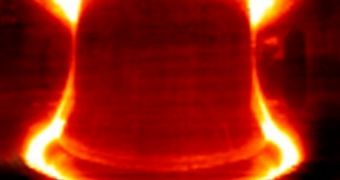A set of experiments conducted at the Massachusetts Institute of Technology's (MIT) experimental Alcator C-Mod reactor has brought the dream of achieving practical nuclear fusion on step closer to reality, scientists report.
The device operated at MIT is the world's most powerful university-based fusion device, and boasts the highest performances of all devices of its kind. Its capabilities are only exceeded by professional test devices, such as the one at the National Ignition Facility (NIF).
What the physicists established was a so-called mode of operations, which is essentially a set of operating parameters in which the device functions vest.
Finding a way of translating these results to other similar devices may result in the solving of a longstanding operational problem, that has been plaguing this field of research for years.
The issue refers to finding a method of keeping the electrically-charged plasma inside the reaction chamber hot, and preventing it from dispersing it. If this happens, the fusion reaction cannot take place.
Nuclear fusion occurs naturally inside the Sun. Under tremendous heat and pressure, hydrogen atoms fuse their cores together, producing helium, and releasing massive amounts of energy in the process.
Physicists want to replicate this on Earth, but in a controlled environment. The main approach to doing that revolves around blasting fuel cells containing the hydrogen isotopes deuterium and tritium with powerful lasers.
The method if however heavily reliant on finding a way to keep the tremendous heat produced b the lasers within the fusion chamber. If the heat escapes, ignition is not achieved, it's that simple.
But this problem also has a twist. The heat needs to be maintained while at the same time contaminating particles need to be removed. These particles can interfere with the main reaction.
After 30 years of research into this conundrum, the MIT group developed a mode of operations that allow particles to escape, all while keeping the heat tightly confined within.
“We seem to have discovered a completely different flushing mechanism … so they don’t build up in the first place,” MIT Department of Nuclear Science and Engineering professor Dennis Whyte says.
“This is very exciting. It really looks distinct” from other approaches, he goes on to say.
But the achievement also brought some other longstanding issues to the table. “Why do heat and particle transport behave differently?” asks University of California in San Diego plasma physics professor Patrick Diamond, PhD.
“This is a really fundamental question, since most theories would predict a strong coupling between the two. It’s a real challenge to us theorists – and important conceptually as well as practically,” he concludes.

 14 DAY TRIAL //
14 DAY TRIAL //